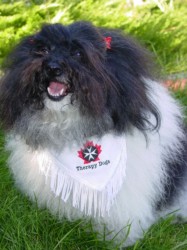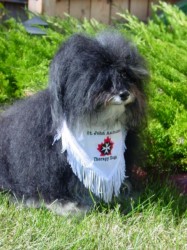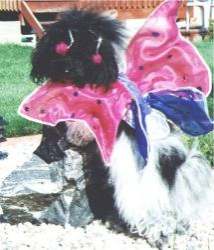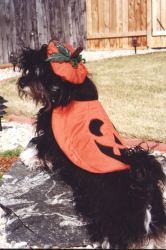Therapy dogs
Havanese make love go round. The little Havanese is made for loving, and cuddles and kisses .....Often, we hear about the virtues of dog ownership. After a stress filled day, how wonderful it is to relax with your pup; perhaps a leisurely walk or a cuddle or a lively game of fetch. Just seeing or touching a dog can be beneficial to a person's health and has been proven to lower heart rate and blood pressure as well as lessening anxiety. Havanese are overflowing with love. Why not consider spreading some of that love around by becoming involved in a Therapy Dog Program.
I have been active in St. John Ambulance Therapy Dogs with three of my Havanese. It is a very rewarding activity that the Havanese is well suited for. A good Therapy dog needs to be calm, gentle and friendly. These and other important traits come naturally to the Havanese. Dog Therapy consists of programs and organizations world wide that offer in-home or facility canine visits. Such friendly, cheerful visits can help lessen feelings of depression, loneliness and isolation. Dogs don't care about things like age, appearance or infirmity, but accept people as they are. Many residents of care facilities have had to give up their beloved pets and greatly miss the companionship and unconditional love. Regular visits give them the opportunity to share feelings and thoughts as well as to reminisce about the past. A short visit can have lasting benefits; many people remain more active and responsive long after we have gone. Weekly visits are eagerly anticipated by residents and staff alike and provide a sunny break from daily routine. Staff often take a moment for a brief hello and a pat, then continue on their way with a smile.



Activities
Havanese are well suited to visits in seniors facilities, nursing homes and hospitals. Their small size is ideal for curling up on a lap or cuddling on a bed. The soft fur is irresitible and just begs to be stroked. Havanese are born clowns (easy to trick train) and love to show off and get attention.
In one of the facilites we visited; many residents assembled in small sitting rooms to enjoy short trick shows followed by cuddles and kisses. With such a visit, a poorly responsive person can become quite animated and talkative, with joy and light shining in their eyes. In that moment; happiness is theirs, all made possible because of a tiny Havanese. Such reactions are heartwarming. Properly qualified dogs are welcomed at a number of facilities. The old attitudes that considered dogs unclean and unwanted in health care facilities are changing as more and more studies prove the benefits. Although some facilities may allow visits from non-certified handlers and dogs, being part of a program has benefits for all involved. Joining a group provides structure, guidance, proper evaluation and certification as well as insurance coverage. Therapy work is not for everyone. Is it for you? Consider sharing the love. The benefits are many and you will get back so much more than you give.
Therapy Dog Test
Any well behaved healthy dog of sound temperament can become a therapy dog. Test requirements vary between organizations; some accept a basic CGC (Canine Good Citizen Certificate) while others have a specific Therapy dog test. Tests evaluate the handlers control of the dog, basic good manners, as well as the dogs reaction to people and other dogs in a variety of situations and distractions.
1) Meeting a friendly
stranger
2) Walking on a loose leash
3) Walking through a crowd
4) Sit and Down on command
5) Praise interaction - (calm down after excitement)
6) Reaction to meeting another dog
7) Accept petting from several people one after another
8) Reaction to completely unresponsive person
9) Accepting petting from multiple people at once
10) Meeting and greeting person in a wheelchair
11) Gently accepting a treat from a stranger
12) Distraction - movement
13) Distraction - noise
The dog will be observed in all the exercises. A dog may be tested twice. A dog may be failed for a number of reasons. Any display of aggression, dominance, growling as well as resentment, extreme shyness and cowering are signs that a dog may be unsuitable for therapy work. Pulling, jumping or straining on the control exercises are also unacceptable. In some cases, failure to pass is due to youthful exuberance or an inexperienced dog or handler. Before re-testing, these dogs will greatly benefit from obedience training, socializing, and perhaps waiting a few more months for the dog to mature.
Typical visit
Here is a typical visit for Rags at a seniors nursing home. As we arrive, we sign in and check with the activities coordinator for special events as well as any new residents or condition changes of our regulars, then on the way by, we stop and say hello to everyone in the office and all the regular staff, then off to start our weekly visit.Rags first stop is one of the small breakfast rooms. Every week we catch the same 4 ladies just finishing breakfast. He pops up with one paw on a knee and cocks his head. Irresistible! They fall for it every time and are ready to scoop him up onto their laps for cuddles. Next we do individual rooms, some for just a quick hello, others for longer visits. Rags knows exactly which residents allow him to hop on the beds and which ones keep dog biscuits in the night table for him.
Food can be an issue as many residents try to feed the dogs including offering such unsuitable items as candy, gum, cake and chocolate. The best way I have found around this is to bring my own treats. I bring a supply of Cheerios. They are tiny, not messy, easy to handle and many Havanese love them. If residents insist on feeding, I just give them a couple of Cherrios to give the dog. The first floor with mainly mobile cognizant residents is where we start and where we spend the most time.
Then its off to the second floor where we have poorly responsive and more senile people. We only spend a brief time here; not because the residents would not enjoy a visit but specifically because of the individual dog. Rags tends to shut down with lack of response, so this is not his best setting. Mitzi with her lively exhuberant nature is better suited to longer visits on this ward. This is followed up by a visit to the third floor where residents are less mobile but more cognisant. As we get there, a music volunteer has just arrived to play for the residents who are assembled in a large sitting room. While she plays, Rags dances for the residents and does a few tricks, followed by hellos and cuddles for all who want it. Then he goes to sit on the piano bench. The music lady makes a big fuss over him and offers him her music book to let him select songs. With a paw or a nose he ALWAYS picks "How Much Is That Doggie", followed by "Bingo" and "Old MacDonald". The residents love it.
By now about 1&1/2 hours has passed and we have visited about 30 residents plus numerous staff members. Rags waves a paw to everyone then back down in the elevator. At the door, his favourite resident is waiting. He pops up in her lap and she takes him for a wheelchair ride in the garden or down the halls. Then, we sign out and our visit is over for another week.Therapy dogs on the job generally wear their therapy scarves, but on special occasions and holidays, my dogs have a wardrobe full of cute costumes. The residents love to see the dogs all dressed up for parties. Our dogs have all learned that dressing up means they are going somewhere special. They get exited as soon as the costume box comes out of the closet.
